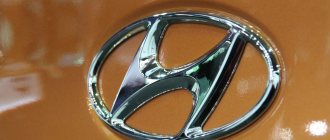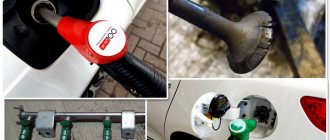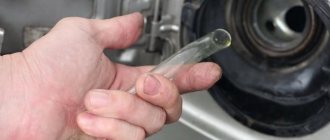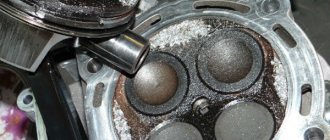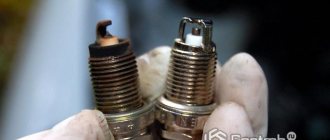Car owners prefer to use high-quality fuel in their car, recommended by the car manufacturer. This allows you to significantly extend the life of the engine and operate the vehicle safely. It is not always possible to find out exactly the chemical formula of the gasoline that is poured into the tank, but if there are concerns about the quality of the fuel offered, then you should look for another gas station.
What is unleaded gasoline?
Unleaded gasoline is a fuel that is produced from petroleum by distilling it into different compositions. The resulting gasoline mixture has high detonation characteristics during compression. A critical level of compression provokes self-ignition before a spark occurs from the spark plug. In other words, detonation occurs too early, which increases wear on the pistons and cylinders, loads the connecting rod and piston group, and leads to an increase in temperatures, due to which the engine overheats greatly.
The parameter that determines the compression ratio at which detonation occurs is called the octane number. Gasoline obtained immediately after oil refining has an octane number of 56-60. This fuel is not suitable for a car.
This indicator can be increased by adding special environmentally friendly additives made from alcohols and ethers to the fuel. This type of gasoline is called unleaded. It is safe for the environment and humans, practically does not clog the car catalyst and is actively used throughout the world.
Unleaded fuel comes in different grades, depending on the octane number.
Are there additives or additives that can prevent phase separation?
In practice, there are no additives that can prevent phase separation. The only practical solution is to prevent water from accumulating in the tank in the first place. Are there additives that, when added to the fuel tank, will remix the separated mixture? No. The only way to avoid further problems is to remove water, dispose of exhausted fuel, and clean the tank; and then you need to start by using fresh dehydrated fuel.
What is leaded gasoline?
Leaded gasoline is essentially the same fuel obtained by distilling oil. However, the required octane number was achieved here by adding tetraethyl lead. This additive makes the fuel toxic. Its exhaust contains too much volatile lead, which, settling in a person’s lungs, leads to serious illnesses. The component also harms plants and animals and greatly pollutes the atmosphere. Also, different brands of leaded gasoline have a detrimental effect on the internal components of the car. In particular, on the engine, exhaust system, catalyst.
For the first time, ethyl impurities began to be added to gasoline mixtures in the 20s of the last century at General Motors. The fact that leaded gasoline is poisonous was carefully hushed up. For a long time they did not talk about its toxicity, but several decades later the truth triumphed. Closer to the 80s, such brands disappeared from the shelves of American gas stations. By the 2000s, this also happened in Europe. In Russia, leaded fuel was officially banned only in 2002.
Let's sum it up! Unleaded gasoline does not contain additives containing tetraethyl lead. It contains alcohol and ether additives that do not destroy the environment. Conversely, leaded one contains ethyl metal-containing mixtures, due to which toxic lead is present in the exhaust. Such brands are prohibited today.
Leading: evolution of the phenomenon
Even someone who does not understand chemistry, looking at the name “tetraethyl lead”, can assume that this substance is most likely unsafe. After all, any lead compounds are toxic. Naturally, this additive was no exception. And, by increasing the fuel's resistance to detonation (that is, increasing its octane number), it introduces lead into the exhaust, which easily spreads into the environment. The situation with the use of leaded technology developed as follows:
- After its discovery in 1921, the substance was actively introduced by the largest American automobile companies, including General Motors, Standard Oil and DuPont.
- By 1950, the use of such fuel had become a de facto industry standard, as manufacturers were impressed that a relatively cheap additive could significantly increase the octane number, and therefore sell their fuel at a much higher price.
- Only in 1972, when massive cases of lead poisoning were registered in the United States, and the US Health Association began to record elevated levels of lead in people’s blood, was the cause established - massive emissions of this substance into the atmosphere due to the use of leaded gasoline.
- In 1976, a radical decision was made to ban the production of this type of fuel in the United States. Despite the opposition of big business, the solution was nevertheless implemented, and leading was stopped.
- Europe took much longer to adapt. It was only in 2000 that leaded gasoline was completely banned, and strict environmental standards for all types of fuel began to be introduced.
After conducting medical research, it was found that the level of lead in the blood of US residents decreased by 86% if we compare the figures in 1976 (when the fight against leaded fuel began) and 2000 (when Europe decided to introduce similar standards).
Therefore, the answer to the question of which gasoline is more toxic is obvious: leaded gasoline was poisonous, but its use is a thing of the past, and today only unleaded fuel is used.
Main brands of unleaded fuel
Let's consider what brands of unleaded gasoline exist, according to GOST:
- AI 80;
- AI 92;
- AI 95 (ECTO and Euro);
- AI 98.
A group of letters indicates that the octane number was isolated by a research method. The numbers express the detonation resistance of the brand.
Also, this Standard identifies several environmental classes of unleaded fuel:
- K2;
- K3;
- K4;
- K5;
- K6
The environmental class determines the level of sulfur and other harmful substances in the exhaust. The higher the class, the cleaner the fuel. For example, eco-class K5, in the same volume of gas cloud, implies 50 times less sulfur than K2. There is no sulfur in unleaded fuel K6. Currently, it is prohibited to produce non-environmentally friendly fuel of class below K5 in the countries that are members of the Customs Union. Branded gas stations from renowned gasoline manufacturers adhere to these standards. But small private networks, as well as some manufacturers from Central Asia, are still “cracking up.”
Remember, when refueling, you have every right to request documents for the fuel poured into the tank. In the technical documentation of any gas station, each brand is designated, by analogy: unleaded gasoline grade AI 92 K5.
Danger for cars
Leaded gasoline (containing tetraethyl lead) has a rather detrimental effect on the exhaust gas converter (catalyst), which is provided in almost all modern cars. Sometimes just one refueling with such fuel is enough for the neutralizer to fail. Its failure is directly related to the lambda sensor, which is responsible for maintaining the oxygen level in the exhaust gases.
From this it should be concluded that the use of leaded fuel, even in rare cases, can disable an imported car, since such cars do not work or work poorly with a damaged exhaust gas catalyst.
In addition, when leaded gasoline enters a vehicle, it causes a number of other problems, since the shock waves generated by the detonation of such fuel destroy engine parts.
Detonation can lead to the following consequences:
- Heat transfer will increase, which will lead to overheating of the power unit.
- The shock wave can destroy the oil film formed on the cylinder walls. This will lead to “dry” friction of the piston group.
- The strong pressure (70 kg/cm2) created during an explosion can damage engine parts.
The combination of these phenomena will significantly reduce the life of the power unit and, most likely, will lead to the need for major repairs.
Main brands of leaded fuel
As we mentioned above, such fuel is prohibited in our country. What brands were in circulation before the ban?
- AI 93;
- A 66;
- A 76.
The letter A in the designation indicates that the octane number was determined by the motor method.
The specified brands of leaded gasoline in the Soviet Union were necessarily subject to tinting (for example, leaded gasoline brand A 76 was green, AI 93 was blue). This way, drivers could identify the fuel without additional research.
The dyes had no effect on the quality of the fuel.
Octane value
Octane number (ON) is the most important characteristic of gasoline, determining the compression ratio at which self-ignition of the fuel (detonation) will occur. In other words, the octane number is determined by the moment when part of the fuel, during compression, ignites not with a spark plug, but spontaneously. Such spontaneous combustion has the nature of a mini explosion. The speed of propagation of the blast wave fluctuates in the range of 1000 – 2300 m/s (with a normal combustion cycle of the air-fuel mixture it is 20 – 30 m/s).
Can you tell the difference by color and smell?
Today, unleaded gasoline is not tinted, and therefore it is problematic to determine the brand by color. How to understand whether a given fuel is leaded or unleaded. Neither the smell nor the consistency will help to make an accurate conclusion. Perhaps ethyl makes the fuel fatty, but it is impossible to judge for sure based on this attribute.
In view of the existing ban, of course, you will be assured that the fuel does not contain toxic metal additives. However, only laboratory analysis will help to verify this for sure.
To protect yourself from low-quality manufacturers and sellers, refuel only at certified gas stations of famous brands. Most of them can already be seen on Yandex maps of gas stations and other applications. Large companies that value their reputation are unlikely to risk their established reputation for the sake of targeted gain.
If you suspect something is wrong, check the spark plugs. Even one consumption of a full tank of leaded fuel is enough for a reddish coating to appear on these elements.
Ways to increase octane number
The octane number can be increased in two ways:
- Purification of gasoline from foreign impurities during the production process. This method is technologically more complex; distillation leads to higher prices for gasoline.
- Leading is an increase in octane number by adding tetraethyl lead, an extremely toxic substance.
Tetraethyl lead affects the central nervous system, causing hallucinations and panic attacks. The substance evaporates at 0°C and can penetrate the human body even through the skin. If you inhale air with a concentration of tetraethyl lead of only 2% for 2-3 minutes, a person begins to have a severe cough and headache, accompanied by loss of concentration of movement.
The additive causes no less harm to the engine, and exhaust gases harm the environment.
Today, the production of leaded fuel is banned in Europe, the USA and Russia. But, despite the ban, the risk of refueling with “dirty gasoline” remains. Unnamed gas stations are especially guilty of this. In pursuit of customers, they are forced to reduce fuel prices, so they act illegally.
To protect yourself and your car from low-quality and dangerous petroleum products, RusPetrol recommends using TNK fuel cards for legal entities and citizens. The company cooperates only with serious oil refining companies whose products meet all regulatory requirements.
When you refuel at the RusPetrol gas station network, you will always be confident in the quality of your gasoline.
A little history
After experimental work with the design of the internal combustion engine, engineers came across a significant problem - the raw fuel actively detonated as soon as it was compressed. In order to eliminate this, the oil had to be subjected to complex processing, which ultimately increased the cost of the mixtures.
Manufacturers were in search of a method that would eliminate detonation as much as possible and would be cheap. After experimental searches, a compound was found - tetraethyl lead, which did an excellent job of the task.
It is the content of this component that has become the main distinguishing feature of how leaded gasoline differs from unleaded gasoline. Very quickly, tetraethyl lead began to be added en masse to fuel. After some time, doctors and environmentalists sounded the alarm - it turned out that lead compounds released during fuel combustion are extremely toxic to humans and the environment. After this, leaded gasoline was banned in almost all developed countries.
